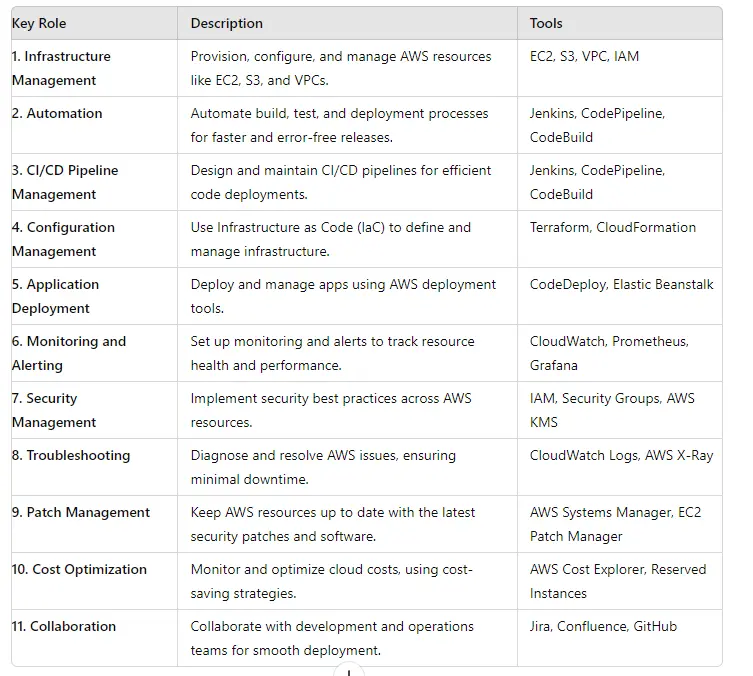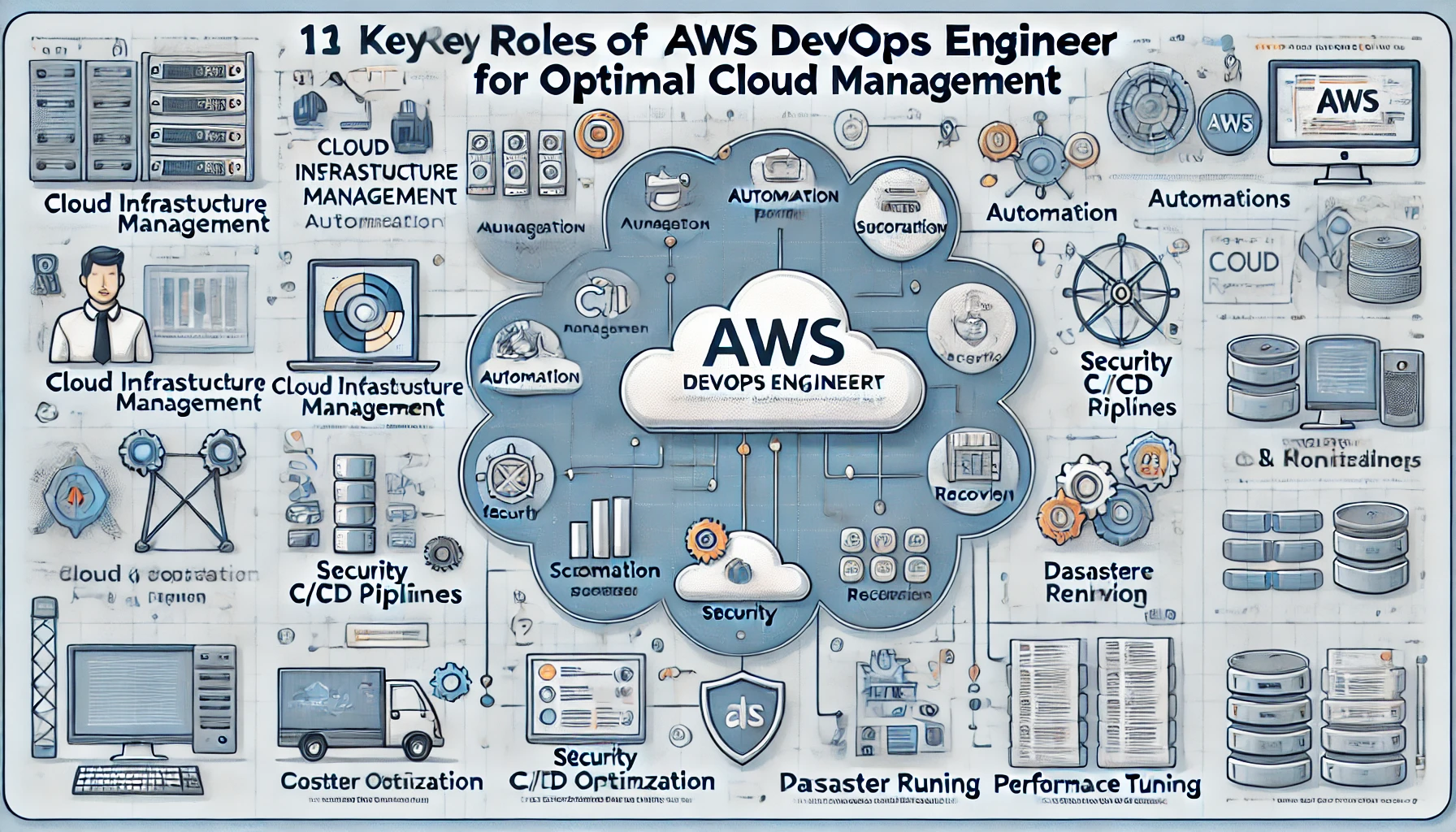In today’s digital era, cloud computing has become a cornerstone of modern infrastructure. As companies increasingly rely on Amazon Web Services (AWS) for their cloud needs, the role of an AWS DevOps Engineer has become crucial. An AWS DevOps engineer ensures that cloud infrastructure, automation, and application deployment run smoothly and efficiently, with an emphasis on scalability, security, and performance. 🌐
Whether you’re a seasoned DevOps professional or someone aiming to transition into this field, understanding the key responsibilities of an AWS DevOps engineer is essential for success in today’s technology-driven landscape. In this blog, we’ll explore the 11 critical roles and responsibilities that an AWS DevOps engineer must master to effectively manage and optimize cloud environments.

1. Infrastructure Management 🛠️
At the core of any cloud setup is infrastructure management. AWS DevOps engineers are responsible for provisioning, configuring, and managing AWS resources such as EC2 instances, S3 buckets, and VPCs to ensure a scalable, secure, and cost-effective environment.
Key Responsibilities:
Provision EC2 instances based on system requirements.
Manage S3 buckets for secure data storage.
Configure VPCs (Virtual Private Clouds) to isolate networks and secure data communication.
Handle autoscaling to ensure resource availability during peak demand.
Practical Example:
Imagine a company needs to host a high-traffic web application. An AWS DevOps engineer will provision the necessary EC2 instances and S3 storage, while ensuring that the VPC is securely configured to prevent unauthorized access.
2. Automation 🤖
Automation is a fundamental responsibility of an AWS DevOps engineer. It ensures that processes such as software builds, tests, and deployments happen without human intervention, reducing errors and improving efficiency.
Key Responsibilities:
Design and implement CI/CD pipelines using tools like AWS CodePipeline or Jenkins.
Automate build, test, and deployment processes to speed up release cycles.
Create scripts to automate repetitive infrastructure tasks.
Practical Example:
By integrating Jenkins with AWS CodePipeline, an AWS DevOps engineer can automate the entire CI/CD lifecycle, ensuring that every code change is automatically tested and deployed to production, reducing downtime and manual errors.
3. CI/CD Pipeline Management ⚙️
In a fast-paced development environment, deploying code changes efficiently and reliably is essential. AWS DevOps engineers are responsible for designing, developing, and managing CI/CD pipelines that automate the software delivery process.
Key Responsibilities:
- Set up CI/CD pipelines to manage code deployments from development to production.
- Use tools like CodeBuild or Jenkins to ensure automated testing and continuous integration.
- Monitor the CI/CD process for potential failures and bottlenecks.
Practical Example:
For a team working on frequent software updates, an AWS DevOps engineer sets up an automated pipeline using AWS CodePipeline, ensuring that each code push is automatically deployed after successful testing, reducing the time between development and production.
4. Configuration Management (IaC) 📑
Configuration management using Infrastructure as Code (IaC) tools ensures that your infrastructure is defined and maintained in a version-controlled and repeatable manner. AWS DevOps engineers use IaC to automate infrastructure provisioning.
Key Responsibilities:
Use Terraform or CloudFormation to define AWS infrastructure resources.
Maintain version control over the infrastructure using declarative configuration files.
Ensure consistent environment setups across development, testing, and production.
Practical Example:
Using Terraform, an AWS DevOps engineer can write reusable configuration files to deploy EC2 instances, databases, and network configurations across multiple environments, ensuring consistency and reducing manual configuration errors.
5. Application Deployment 🚀
Deploying applications efficiently in the cloud is a key responsibility for AWS DevOps engineers. They manage application deployments using AWS-specific tools to ensure reliable and scalable deployment practices.
Key Responsibilities:
Use AWS tools like CodeDeploy or Elastic Beanstalk for smooth application deployment.
Implement blue/green deployment strategies to minimize downtime during updates.
Automate the deployment process to ensure scalability and reduce manual errors.
Practical Example:
An AWS DevOps engineer can use AWS Elastic Beanstalk to deploy a web application without worrying about the underlying infrastructure. Elastic Beanstalk handles scaling, load balancing, and monitoring automatically.
6. Monitoring and Alerting 📊
Monitoring is crucial for maintaining the health and performance of AWS resources and applications. AWS DevOps engineers set up monitoring systems to track performance metrics and alert teams when something goes wrong.
Key Responsibilities:
- Set up CloudWatch to monitor resource utilization, performance, and health.
- Define alerts for critical issues like high CPU usage, memory leaks, or downtime.
- Implement monitoring tools like Prometheus or Grafana for custom metrics and dashboards.
Practical Example:
An AWS DevOps engineer sets up CloudWatch alarms to notify the operations team if CPU utilization exceeds 80% on a critical EC2 instance, allowing for proactive troubleshooting and load balancing.
7. Security Management 🔒
Security is a top priority in any AWS environment. AWS DevOps engineers are responsible for implementing security best practices, from IAM role management to data encryption.
Key Responsibilities:
Manage IAM roles and policies to ensure proper access controls.
Implement security groups and network ACLs to secure the AWS environment.
Use AWS Key Management Service (KMS) to handle encryption and secure sensitive data.
Regularly audit AWS resources for compliance with security standards.
Practical Example:
For a company dealing with sensitive customer data, an AWS DevOps engineer configures IAM roles with least-privilege access and ensures that S3 buckets are encrypted with AWS KMS, maintaining data confidentiality.
8. Troubleshooting 🛠️
When things go wrong (and they inevitably will), AWS DevOps engineers must diagnose and resolve issues as quickly as possible to minimize downtime.
Key Responsibilities:
Analyze logs and metrics from CloudWatch and AWS X-Ray to diagnose issues.
Work closely with developers and operations teams to resolve bugs or misconfigurations.
Implement rollback strategies for quick recovery from deployment failures.
Practical Example:
When a production application starts showing 500 errors, the AWS DevOps engineer uses CloudWatch Logs and AWS X-Ray to trace the issue back to a misconfigured API gateway, fixing the error before it causes significant downtime.
9. Patch Management 🛡️
Keeping AWS resources up to date is crucial for security and performance. AWS DevOps engineers ensure that all AWS instances are running the latest security patches and software versions.
Key Responsibilities:
Regularly update EC2 instances and other AWS services with the latest patches.
Use AWS tools like Systems Manager to automate patching across multiple environments.
Ensure that applications and infrastructure are compliant with security standards.
Practical Example:
For a critical web application running on multiple EC2 instances, an AWS DevOps engineer automates patch management using AWS Systems Manager to ensure that all instances receive the latest security updates without manual intervention.
10. Cost Optimization 💰
AWS DevOps engineers are responsible for managing cloud costs effectively by optimizing resources and identifying cost-saving opportunities.
Key Responsibilities:
Use AWS Cost Explorer to monitor and track spending across AWS resources.
Implement autoscaling to ensure that the company only pays for the resources it needs.
Use Reserved Instances and Savings Plans to reduce overall cloud costs.
Practical Example:
By analyzing spending with AWS Cost Explorer, an AWS DevOps engineer identifies that the team can save 30% on computing costs by switching to Reserved Instances for long-running EC2 workloads, instead of relying on on-demand pricing.
11. Collaboration 🤝
One of the most critical aspects of being an AWS DevOps engineer is working closely with developers, operations teams, and other stakeholders to ensure smooth delivery and operation of cloud applications.
Key Responsibilities:
Work with development teams to integrate CI/CD pipelines and automation tools.
Collaborate with operations teams to monitor the health of cloud applications.
Ensure that business stakeholders are informed about the health and cost efficiency of AWS resources.
Practical Example:
An AWS DevOps engineer collaborates with the development team to integrate a new automated test suite into the existing CI/CD pipeline, ensuring that all code changes are thoroughly tested before deployment.
Conclusion: The Multifaceted Role of an AWS DevOps Engineer 🌟
The role of an AWS DevOps Engineer is multifaceted, covering everything from infrastructure management to automation, security, and cost optimization. To succeed in this role, engineers must leverage a wide array of tools and best practices to ensure that cloud environments are efficient, secure, and scalable.
By mastering these 11 key responsibilities, AWS DevOps engineers can significantly impact a company’s ability to deliver high-quality software quickly and reliably, while keeping costs in check and ensuring a secure, compliant infrastructure.
So, whether you’re just starting out in DevOps or you’re a seasoned pro, these responsibilities will guide you in becoming an essential asset to any organization leveraging the power of AWS. 🌐























